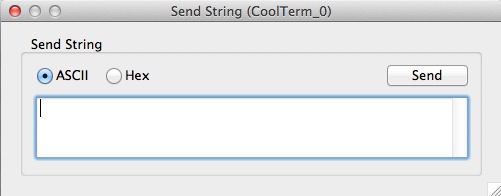

- Led display coolterm without being connected how to#
- Led display coolterm without being connected install#
- Led display coolterm without being connected serial#
- Led display coolterm without being connected code#
- Led display coolterm without being connected tv#

Just started today.īooting without battery, strictly from power supply Like I said, after it boots, I can unplug the HDMI and use it normally, but it’s really an issue for me. I know people have had issues with their screens not working and using HDMI for picture, but my laptop will literally not boot unless it is plugged into HDMI before powering on. This is the weirdest issue I have ever seen and cannot find anything online about it, expect for a couple of similar (not same) issues. I’m using it right now, but only after using HDMI first as described. But if I try to restart or shut down and try to turn back on, the same issue happens again and I have to plug it back into HDMI to get it to boot at all. It booted up perfectly just like it normally should.
Led display coolterm without being connected tv#
I have to hold the power button down to turn it back off, then try again with same results.Įven though I noticed the HDD light wasn’t on, I thought it could possibly be just my screen not working so I plugged it in through HDMI to my TV and powered it on. The power button lights up, the HDD indicator light and keyboard backlight come up very briefly then go back off, and the screen stays black. Went to turn it on today and it wouldn’t boot…at all.
Led display coolterm without being connected how to#
See this hackster make for Mac or this make for Windows for more on how to use Node for handling serial.I used my laptop yesterday with no issues, shut down as usual, etc.
Led display coolterm without being connected serial#
Led display coolterm without being connected install#
You may need to install the screen program if you don't already have it.
Led display coolterm without being connected code#
The Mu editor for Python allows you to read and plot serial input, and also features REPL (Read-Eval-Print-Loop), allowing you to write & test code on your micro:bit in real-time. Clicking the blue button in the right corner will generate a CSV file, which allows you to view and edit the serial data in Excel. Write a program using the serial blocks and flash it to the micro:bit, then click Show console Device to view a plot of serial data. MakeCode allows you to read and plot serial data from the micro:bit, allowing you to accurately log data from the device's sensors.Ĭonnect your micro:bit to the computer with a USB cable then open in a Chrome-based browser. Note that WebUSB is currently only supported by Chrome.ĭiscover how to use WebUSB in this knowledge base article. The Python editor also features REPL (Read-Eval-Print-Loop), allowing you to write & test code on your micro:bit in real-time. WebUSB is still in beta we're currently looking for help testing it, and we'd love for you to get involved.īoth editors allow you to stream and plot serial data in-browser. WebUSB allows you to read serial data in your web browser using the Python or JavaScript Blocks editors. Using a computer terminal or serial program.Once you have programmed your micro:bit you will need a way of sending and receiving serial data on the connected computer using one of these options: You can read or write serial data in JavaScript Blocks using the advanced serial blocks. You can read serial messages from the computer using the UART module. In Python, the 'print' statement sends a string from the micro:bit to the connected computer over serial. You can send and receive data over serial on the micro:bit using both Python and Makecode for micro:bit.

This is useful for debugging programs as well as data logging, or using your micro:bit as a controller for your computer. When your micro:bit is connected to a computer with a USB cable it is able to send and receive data using 'serial' communication.


 0 kommentar(er)
0 kommentar(er)
